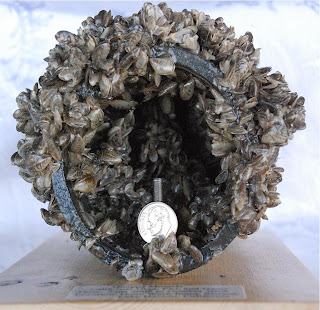It’s been a long journey, but we are happy to report that
two snakeheads are now in the new Invasive Species exhibit at the Tennessee Aquarium. This tank calls attention to one of the most
serious threats to our native animals: species that have been accidentally or
purposefully released outside their native range. As you study this tank full of “unwanted”
animals, you will see the shells of Zebra Mussels (Dreissena polymorpha), and Asian
Clams (Corbicula fluminea), in
addition to Yellow Perch (Perca flavescens), Redbreast Sunfish (Lepomis
auritus), Grass Carp (Ctenopharyngodon idella), and Northern Snakeheads
(Chana argus). Each of these species has an impact on the
ecosystem it has been introduced into, some more drastic than others.
Zebra Mussels and Snakeheads have been two of the most
expensive invasive species our country is battling. Zebra mussels are native to Eurasia and were
first found in the Great Lakes in the 1980s.
They were most likely introduced by ballast water from barges as they
entered harbors and waterways. Since
then, Zebra Mussels have spread rapidly, densely colonizing virtually any
surface, including other aquatic animals!
They outcompete native mussels for food and habitat, and millions of
dollars are spent each year de-fouling industrial pipes clogged with zebra
mussels.
 |
| Zebra mussels growing on a crayfishFrom: http://dnr.wi.gov/org/caer/ce/eek/critter/invert/zebramussel.htm |
 |
Pipe
clogged with zebra mussels
|
Snakeheads are another invasive species that has gotten a
lot of attention lately. Due to their
snake-like appearance, mouth full of sharp teeth, and ability to breathe air
and “crawl” over land, the media has dubbed this animal “Frankenfish.” While this name may be a bit harsh, there is
no doubt that snakeheads have the potential to severely degrade an area where
they are introduced. They are voracious
predators and highly territorial; therefore they can outcompete popular
sportfish, like bass, for food. They are
also aggressive, especially during breeding season as they guard their eggs and
larvae. There are no established
populations in Tennessee right now, though one snakehead was caught near Memphis
in 2006. There are established populations
in Virginia, Florida, and Arkansas, however.
The largest eradication attempt in the U.S. was performed over 110
square miles in the Piney Creek drainage in Arkansas. Biologists attempted to poison what they
thought was a contained population. This
massive project was successful in diminishing the snakehead population, but was
unsuccessful in eradicating the river of
them. It is illegal to possess a
snakehead in the state of Tennessee.
 |
Northern Snakehead at
the Tennessee Aquarium
|
We are able to display these species thanks to funding from
the Tennessee Wildlife Resources Agency. Come visit the Aquarium to see our new
exhibit in the Tennessee River Gallery of the River Journey building. And remember--you can help prevent the spread
of invasive species. After being on the
water, check your boat and equipment for aquatic hitchhikers, clean thoroughly
after each use, and dry before use in a different waterbody.

1 comment:
Place the compression nut and compression ring over the end of the pipe, as shown above, then insert the pipe into the compression seat. Then using two wrenches, one to hold the fitting and the other for the compression nut, tighten the compression nut completely. This forces the compression ring unto the pipe, creating a water tight seal.
Fixing A Pipe
Post a Comment